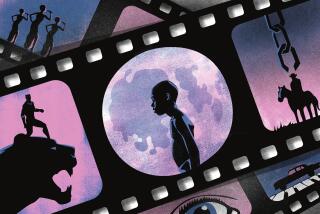‘Killer of Sheep’ is a timeless wonder
- Share via
“Killer of Sheep” is a wonder any number of ways, from how it was originally made to its reappearance now in handsomely restored form to its getting its first-ever theatrical release (at the Nuart in West Los Angeles) a full 30 years after it was completed.
But the greatest wonder of all is that this 1977 film, made for $10,000 by filmmaker Charles Burnett while he was still at UCLA’s film school and shot on weekends in Watts with a mostly amateur cast, still has the power to move us.
For while blunter, more blustery films have become yesterday’s news, almost nothing about this quiet film has dated. That is in part a tribute to Burnett’s gifts, which blossomed in subsequent African American-themed works like the marvelous Danny Glover-starring “To Sleep With Anger” and the too-little-seen “Nightjohn.” But it also speaks to the enduring power of poetic cinema, of films with genuine artistic vision that create mood and capture emotion in ways only motion pictures can.
The fact that “Killer of Sheep” has been all but unseeable for years has not hurt its reputation. It’s considered such a landmark of both American independent and African American cinema that it was one of the first 50 culturally significant films selected for preservation in the Library of Congress by the National Film Registry. All this for a film made so close to the bone that Burnett served as writer, director, producer, editor and cameraman. A film that is more episodic than plot driven, that offers a character-centered portrait of a community rarely seen on film to this day: people of color who are part of the working poor, living from check to check and trying to make ends meet and get ahead.
Stan (Henry Gayle Sanders), “Killer of Sheep’s” protagonist, is inevitably exhausted from his work in a slaughterhouse, but the film finds him unable to sleep. He is in the grip of a kind of existential despair that keeps him from smiling, a malaise that puts him in a place where even his frustrated wife (Kaycee Moore) has difficulty reaching him. There are no conventional narrative or character arcs in “Killer of Sheep.” Rather, the film follows Stan through random incidents, events that add up to a portrait of futility, a frustrating inability to feel successful and in control. Yet there are also moments of beauty and pleasure that occur unexpectedly and add meaning to life.
We listen in as Stan is visited by two friends who want him to be part of a criminal plan. We are there when a white woman who owns a liquor store blatantly comes on to him. And we watch in almost despair as complicated negotiations and plans for something as simple as buying an engine in order to fix up a car come to an unfortunate end.
One of the strengths of “Killer of Sheep,” one of the reasons it has not dated, is that the naturalness and simplicity with which it unfolds give it the texture of a story told from the inside. The film’s sensitivity to mood and moment create a privileged glimpse of reality -- scenes like Stan and his wife slow dancing to Dinah Washington singing “This Bitter Earth” -- that are indelible.
“Killer of Sheep’s” musical component is one of its most ambitious aspects. Burnett has said he envisioned it as an aural history of African American popular music, and it includes artists like Little Walter, Elmore James, Arthur “Big Boy” Crudup and Earth, Wind and Fire.
The cost and trouble of clearing the music rights for theatrical distribution was one of the reasons the film had such a tough time getting release: It took six years and cost $150,000 to do the job. But without those haunting sounds floating over its inexpressibly lyrical images, “Killer of Sheep” would not be the classic it remains.
*
“Killer of Sheep.” Unrated. Running time: 1 hour, 20 minutes. Exclusively at the Nuart, 11272 Santa Monica Blvd., West Los Angeles. (310) 281-8223.
More to Read
Only good movies
Get the Indie Focus newsletter, Mark Olsen's weekly guide to the world of cinema.
You may occasionally receive promotional content from the Los Angeles Times.











